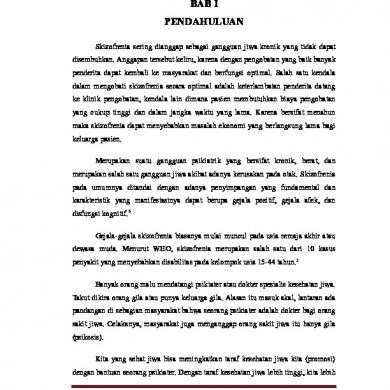Fundamentals X-ray Diffraction
This document was uploaded by user and they confirmed that they have the permission to share it. If you are author or own the copyright of this book, please report to us by using this DMCA report form. Report DMCA
Overview
Download & View Fundamentals X-ray Diffraction as PDF for free.
More details
- Words: 624
- Pages: 14
Loading documents preview...
X-RAY DIFFRACTION ARIF MAMUN AZAD ROLL NO – CHM165046 YEAR- 3rd SEMESTER-6th CODE –PS 332
ALIAH UNIVERSITY,
KOLKATA,160
What are X-rays ?
Generation Of X-rays : When a free electron is collided with a heavy atom(Mo, W, Cu, Al etc) it knocks an electron of the lower orbital of the atom ;an electron from its higher orbital immediately falls to the lower orbital to fill the gap releasing an extra energy as an X-ray photon
Production of X-rays :
X-rays are produced experimentally when high speed electrons are collided with a metal target (generally Mo, W, Cu, Al)
A source of electron is hot W filament; a high accelerating voltage (~10k eV) between cathode(W) and anode and a metal target .
Anode is a water cooled block of Cu containing desired target metal .
What is X-ray diffraction The most convenient and widely used method to determine the structural properties of solid crystals
Types of X-ray related spectroscopies:
(i) X-ray absorbance
(ii) X-ray diffraction
(iii) X-ray fluorescence
Every crystalline substance gives a pattern, same for the substance and mixture of substances each produces its pattern independently .
Therefore XRD pattern is like a fingerprint of substance . It`s based on scattering of X-rays by crystals .
Definition:- The atomic planes of a crystal cause an incident X-ray beam to interfere one another .This phenomenon is called X-ray diffraction .
Why XRD ?
A novel, non destructive, cheapest, in situ method
Measures the average spacing between the layer or rows of atoms
Determines the orientation of a single crystal an d also polycrystals or grains
Measure the size, shape and internal stress of smaller crystalline regions
Modern X-ray diffractometer
Sample preparation Powders
0.1um <
(Peak broadening)
particle size
<
40um
(Less diffraction occurring)
Bulks:- smooth surface after polishing specimen should be thermally annealed eliminate any surface deformation induced during polishing
Bragg`s law
Detection of diffracted X-ray on photographic plate :
A sample of some hundred crystals (i.e. powdered sample) show that the diffracted beam from continuous cones . A circle of films is used to record the diffracted pattern as shown .
Each cone intersects the film giving diffracted lines . The lines are seen ass arcs on the film
Basics of crystallography
The atoms are arranged in a regular pattern and there`s as smallest volume element that by repetition in 3D describes the crystal . The smallest volume element is called a unit cell .
Crystals consist of atoms that are spaced a distance apart, but can be resolved into many atomic planes, each with a different spacing .
The dimensions of the unit cell is described by 3 axes a,b,c and angles between them is A,B,C and are lattice constants which can be determined using XRD .
Miller Indices :
The LCM multiplied to the reciprocals of the fractional intercepts which the plane makes with crystallographic axes .
The axial length
Intercepts
Miller indices
XRD methods Laue method
Rotating crystal method
Debye Scherer (powder method)
Orientation Single Crystal Polychromatic beam
Lattice constant Single Crystal Monochromatic beam
Lattice parameter Polycrystal Monochromatic beam
Fixed angle
Variable angle
Variable angle
Applications of XRD (i)
Determination of the structure of the crystalline materials .
(ii)
Determination of electron distribution within atom throughout the cell .
(iii)
Determination of orientation of single crystals .
(iv)
Diffractions improved by computer technologies used to determine the atomic structure and in various medical application like drug, biomolecules structure elucidation and their working function to living cells .
Disadvantage:- X-rays do not interact strongly with lighter
elements so as C-H bonds . So X-rays can`t determine the protein structures .
ALIAH UNIVERSITY,
KOLKATA,160
What are X-rays ?
Generation Of X-rays : When a free electron is collided with a heavy atom(Mo, W, Cu, Al etc) it knocks an electron of the lower orbital of the atom ;an electron from its higher orbital immediately falls to the lower orbital to fill the gap releasing an extra energy as an X-ray photon
Production of X-rays :
X-rays are produced experimentally when high speed electrons are collided with a metal target (generally Mo, W, Cu, Al)
A source of electron is hot W filament; a high accelerating voltage (~10k eV) between cathode(W) and anode and a metal target .
Anode is a water cooled block of Cu containing desired target metal .
What is X-ray diffraction The most convenient and widely used method to determine the structural properties of solid crystals
Types of X-ray related spectroscopies:
(i) X-ray absorbance
(ii) X-ray diffraction
(iii) X-ray fluorescence
Every crystalline substance gives a pattern, same for the substance and mixture of substances each produces its pattern independently .
Therefore XRD pattern is like a fingerprint of substance . It`s based on scattering of X-rays by crystals .
Definition:- The atomic planes of a crystal cause an incident X-ray beam to interfere one another .This phenomenon is called X-ray diffraction .
Why XRD ?
A novel, non destructive, cheapest, in situ method
Measures the average spacing between the layer or rows of atoms
Determines the orientation of a single crystal an d also polycrystals or grains
Measure the size, shape and internal stress of smaller crystalline regions
Modern X-ray diffractometer
Sample preparation Powders
0.1um <
(Peak broadening)
particle size
<
40um
(Less diffraction occurring)
Bulks:- smooth surface after polishing specimen should be thermally annealed eliminate any surface deformation induced during polishing
Bragg`s law
Detection of diffracted X-ray on photographic plate :
A sample of some hundred crystals (i.e. powdered sample) show that the diffracted beam from continuous cones . A circle of films is used to record the diffracted pattern as shown .
Each cone intersects the film giving diffracted lines . The lines are seen ass arcs on the film
Basics of crystallography
The atoms are arranged in a regular pattern and there`s as smallest volume element that by repetition in 3D describes the crystal . The smallest volume element is called a unit cell .
Crystals consist of atoms that are spaced a distance apart, but can be resolved into many atomic planes, each with a different spacing .
The dimensions of the unit cell is described by 3 axes a,b,c and angles between them is A,B,C and are lattice constants which can be determined using XRD .
Miller Indices :
The LCM multiplied to the reciprocals of the fractional intercepts which the plane makes with crystallographic axes .
The axial length
Intercepts
Miller indices
XRD methods Laue method
Rotating crystal method
Debye Scherer (powder method)
Orientation Single Crystal Polychromatic beam
Lattice constant Single Crystal Monochromatic beam
Lattice parameter Polycrystal Monochromatic beam
Fixed angle
Variable angle
Variable angle
Applications of XRD (i)
Determination of the structure of the crystalline materials .
(ii)
Determination of electron distribution within atom throughout the cell .
(iii)
Determination of orientation of single crystals .
(iv)
Diffractions improved by computer technologies used to determine the atomic structure and in various medical application like drug, biomolecules structure elucidation and their working function to living cells .
Disadvantage:- X-rays do not interact strongly with lighter
elements so as C-H bonds . So X-rays can`t determine the protein structures .
Related Documents

Fundamentals X-ray Diffraction
March 2021 0
Boiler Fundamentals
January 2021 0
Boiler Fundamentals
January 2021 0
Fundamentals Blower.pdf
February 2021 1
Bioenergetic Fundamentals
January 2021 0
Superpave Fundamentals
January 2021 2More Documents from "project list"

Fundamentals X-ray Diffraction
March 2021 0
Finite Automata Tk 4.docx
January 2021 1
Referat Skizofrenia Rskj Dharma Graha
March 2021 0
Seismic Load Computation
February 2021 0
Social Sciences_sociology.pdf
February 2021 0